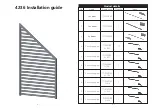
20
2.1.2.1 Interlocks
The unit is provided with a dual channel external interlock circuit that may be used to link to
interlock switches on the high voltage test area. The test area must be interlocked.
An interlock should be considered to be a safety back-up feature. An interlock should not be
regarded as a substitute for adequate safety rules and proper operator vigilance.
2.1.2.2 Grounding of the High Voltage Output
A temporary ground should be applied to the high voltage output when the circuit has been de-
energised using the earth stick provided. When connections are made or disconnected, the
circuit either side of the connection should be grounded first. Extra earth sticks are available
from T&R Test Equipment as an optional accessory. Alternatively an automatic earthing
system can be implemented under the control of the output provided (refer to section 1.3.3).
If the test circuit includes capacitors, each capacitor should be grounded separately before
connections are made or broken. In the case of capacitors connected in series, the
intermediate terminals should also be grounded.
It is good practice for all capacitive devices to remain short-circuited when not in use.
2.1.2.3 High Voltage Connection
The HV connection to the test object must be made securely, and suitable stress relief
components should be used where required to keep electrical stresses within acceptable
limits. The KV series are designed to be used with an air-insulated output conductor. No HV
connection lead is supplied with the KV series units.
2.1.2.4 High Voltage Output Clearances
The high voltage output from the unit is from a bushing, and adequate clearances (distances
between objects through the air) must maintained between the following parts and any other
conducting object (whether earthed or not):
HV bushing
Wiring connected to HV bushing
Non-grounded parts of test object
Any part of the test object not connected to earth should be considered live at the test voltage.
The clearances required when high voltage testing may be split into two groups
– functional
clearances and safety clearances.
Functional clearances relate to the clearances entirely within the test enclosure to ensure
that there is no risk of breakdown. These distances will need to be increased when partial
discharge testing.
Safety clearances are the clearances required to ensure the safety of personnel at all
times, and relate to clearances that may affect the test enclosure or personnel outside the
test enclosure. Safety clearances will always be higher than functional clearances. Safety
clearances may be obtained from BSEN50191:2001.
EN50191 defines prohibition zones for high voltage, describing a volume around high
voltage parts that personnel or their tools must not be able to reach. The prohibition zones
Summary of Contents for KV mk2 Series
Page 28: ......
Page 30: ...30 Drawings 001555 KV100 100 001808 KV30 100T ...











































